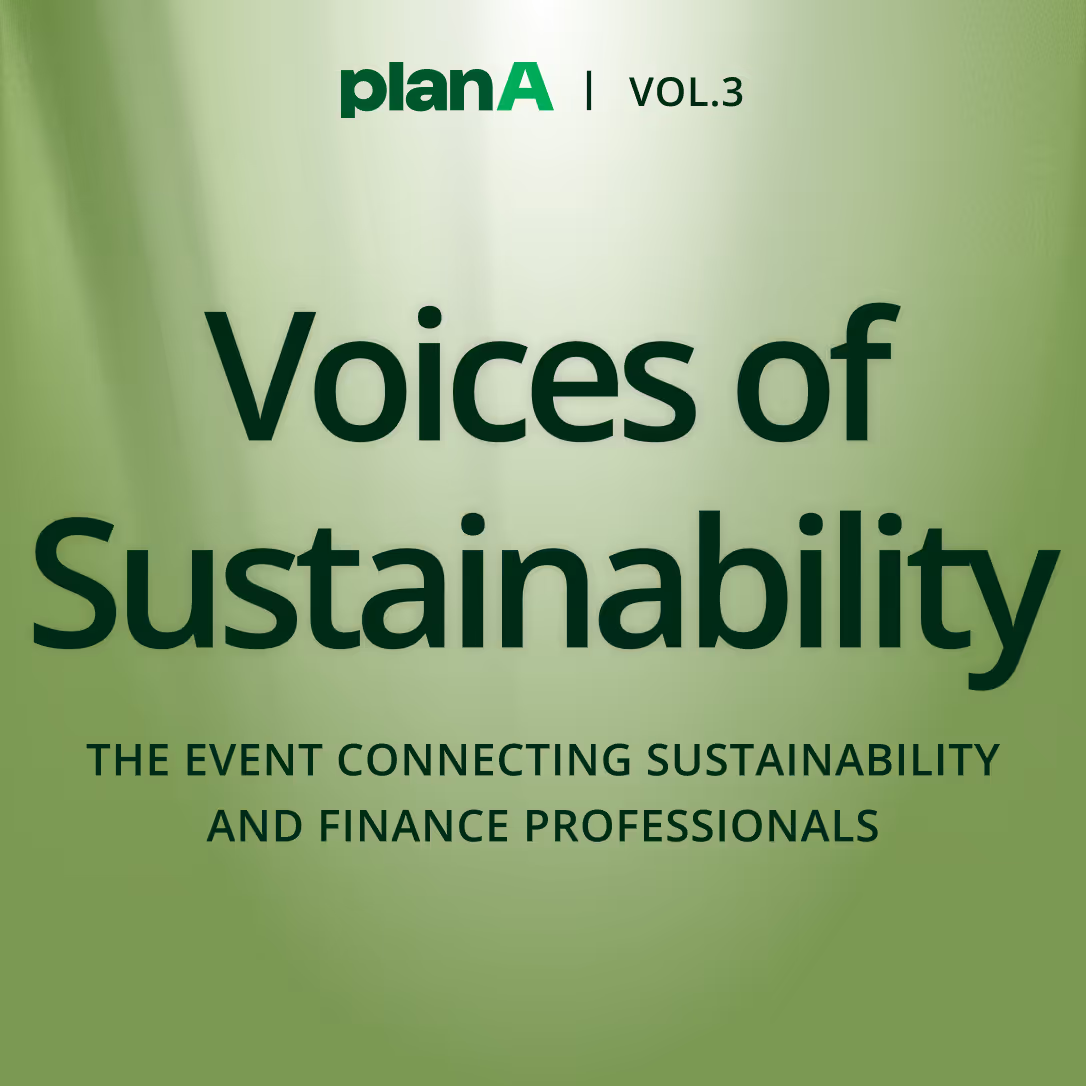A fresh study from The Conference Board analysing over 250 companies reveals the ten priorities shaping corporate sustainability strategies in 2025. While policy shifts top the list, the findings expose a landscape where regulatory fragmentation meets operational complexity, and where success depends on moving beyond compliance to strategic integration.
This article examines these priorities through the lens of sustainability teams navigating real-world challenges, incorporating insights from practitioners who've witnessed the evolution firsthand.
Policy shifts reshape the sustainability landscape
The most significant challenge facing sustainability professionals in 2025 is adapting to rapidly evolving policy environments. The Conference Board's research identifies policy shifts as the top corporate sustainability priority, with 80% of sustainability executives adjusting their strategies in response to changing regulatory landscapes.
The most striking changes have occurred in the United States, where federal climate policy has pivoted toward expanding fossil fuel development and scaling back clean energy incentives. The Securities and Exchange Commission's withdrawal of its federal climate disclosure rule represents a fundamental shift in regulatory expectations, forcing companies to recalibrate their reporting strategies.
However, this federal retreat doesn't signal the end of sustainability regulation. California's SB 253 and SB 261 laws maintain robust climate disclosure requirements for companies with significant revenue in the state, creating a patchwork of jurisdictional requirements that sustainability teams must navigate.
Companies are responding with practical adjustments: 52% are narrowing or reframing their ESG communications, whilst 48% are increasing legal and risk review processes. Many organisations are substituting charged terms like "ESG" with more neutral language such as "sustainability" or "resilience" to avoid political controversy whilst maintaining substantive programmes.

As Christoph Bock from RTL2 Fernsehen notes in Plan A's Voices of Sustainability initiative:
If your company is affected by the Omnibus Proposals, it may be helpful to consider 'staying the course.' The climate crisis remains acute. We have therefore decided to remain committed to pursuing our sustainability agenda with determination.
The strategic response requires balancing political sensitivity with business fundamentals. Companies must anchor their sustainability strategies in measurable value creation whilst adapting communications to evolving stakeholder expectations.
Regulatory complexity demands sophisticated reporting approaches
ESG reporting regulations continue expanding globally, creating unprecedented complexity for multinational corporations. The European Union's Corporate Sustainability Reporting Directive (CSRD) remains in effect despite ongoing revisions through the Omnibus initiative, which has delayed applicability for non-EU companies from 2028 to 2030.
California's climate disclosure laws exemplify the fragmented regulatory landscape. SB 253 requires companies with over $1 billion in California revenue to disclose scope 1-3 greenhouse gas emissions with third-party assurance, whilst SB 261 mandates climate risk reports following Task Force on Climate-related Financial Disclosures (TCFD) recommendations.

This regulatory divergence presents strategic choices for sustainability teams. Some companies adopt minimum compliance approaches to limit legal exposure, particularly in politically volatile markets. Others align with the highest global standards to bolster investor confidence and future-proof their reporting capabilities.
The most effective approach requires treating ESG data with financial-grade standards. This means implementing robust internal controls, engaging audit committees early in the process, and establishing systems capable of supporting external assurance requirements.
Demonstrating return on investment becomes essential
The pressure to demonstrate measurable return on investment (ROI) for sustainability initiatives has intensified significantly. Only 9% of surveyed executives rate their ability to measure sustainability ROI as good or excellent, whilst 38% consider it poor, highlighting a critical capability gap.
This ROI challenge reflects broader economic pressures. Inflation, supply chain disruption, and geopolitical uncertainty have heightened executive scrutiny of all investments, including sustainability programmes. Boards and C-suite leaders expect credible evidence that sustainability initiatives drive operational efficiency, mitigate risks, and contribute to long-term value creation.
The most effective sustainability teams start with direct, measurable returns. Energy efficiency programmes typically offer the clearest ROI demonstration, with companies achieving 10-30% cost reductions through optimised energy consumption. Water conservation initiatives provide similar clarity, particularly for manufacturing operations in water-stressed regions.
McKinsey's analysis of over 2,200 companies reveals that "triple outperformers", companies excelling in growth, profitability, and ESG, generate an annual total shareholder return premium of 2 percentage points over purely financial performers and 7 percentage points over average performers.
Building credible ROI measurement requires collaboration across functions. Sustainability teams must work closely with finance, procurement, human resources, and operations to establish consistent measurement frameworks and shared accountability structures.
Climate strategy evolves beyond compliance
Climate strategy remains a fundamental priority, with over 80% of S&P 500 companies now publicly identifying climate change as a business risk. However, the focus has shifted from basic disclosure toward strategic integration into core business operations.
The most advanced companies are embedding climate considerations into enterprise risk management frameworks, capital allocation processes, and executive compensation structures. This integration addresses both physical risks, extreme weather events, drought, flooding, and transition risks related to policy changes and evolving disclosure requirements.
Scope 3 emissions present the greatest strategic challenge. These indirect emissions across value chains typically represent 65-75% of a company's total carbon footprint, yet remain the most difficult to measure and influence. Companies are investing in supplier engagement programmes, enhanced data collection systems, and collaborative industry initiatives to address these challenges.

As noted by Nathan Bonnisseau, Plan A's co-founder:
Having a platform that guides you toward the best actions and highlights emissions hotspots is where technology really makes a difference.
Supply chain transparency drives competitive advantage
Supply chain sustainability has evolved from a compliance obligation to a strategic differentiator. Companies recognise that most environmental and social impacts, including scope 3 emissions, deforestation, and human rights issues, occur upstream in their value chains.
Regulatory pressure is accelerating this shift. The EU's Corporate Sustainability Due Diligence Directive and Deforestation-Free Products Regulation will require many companies, including large US-based multinationals, to identify, prevent, and address environmental and human rights risks across their global operations.
The Uyghur Forced Labor Prevention Act demonstrates how geographically targeted regulations can reshape global supply chain practices. While focused on China's Xinjiang region, the compliance requirements, including end-to-end traceability, third-party verification, and comprehensive supplier due diligence, signal broader expectations for supply chain transparency.
Companies are responding with multi-tiered approaches. Initial efforts focus on tier-one suppliers, establishing clear expectations and monitoring systems. Advanced programmes extend visibility into tier-two and tier-three suppliers, where many of the highest-risk activities occur.
Over half of firms surveyed by The Conference Board in May 2025 reported increased focus on human rights in supply chains, with 7% significantly increasing their efforts and 45% somewhat increasing their attention to these issues.
Question: “In 2025, has your organization changed its focus on human rights in the supply chain due to evolving political and regulatory developments in the US and Europe?”
Respondents: 29 poll respondents:
The most effective supply chain sustainability programmes combine technology solutions with collaborative industry initiatives. Companies are investing in blockchain-based traceability systems, satellite monitoring for deforestation risks, and shared supplier assessment platforms to improve visibility whilst reducing individual compliance burdens.
Water stewardship addresses localised risks
Water stewardship has emerged as a critical priority, particularly for companies operating in water-stressed regions. Prolonged drought conditions in the US Southwest, Texas, and Colorado River Basin have intensified both physical and regulatory risks for water-intensive industries.
Corporate water consumption data shows encouraging trends, with median usage among S&P 500 companies declining from 2.4 million cubic metres in 2022 to 1.7 million cubic metres in 2024. This reduction reflects both efficiency improvements and strategic risk management.
Water strategies are becoming increasingly localised. Companies are conducting watershed-level assessments to understand regional water availability and implementing science-based targets aligned with local water stress levels. Advanced recycling technologies and precision irrigation systems are reducing consumption whilst maintaining operational effectiveness.
.avif)
Collaboration with local stakeholders is essential for effective water stewardship. Companies are partnering with municipal authorities, agricultural organisations, and environmental groups to develop shared water management strategies that ensure long-term operational continuity whilst supporting community needs.
Biodiversity emerges as a strategic priority
Biodiversity has gained significant traction as a corporate sustainability priority, with 59% of S&P 500 companies now maintaining biodiversity policies, up from 29% in 2021. This growth reflects increasing recognition that natural ecosystems underpin food security, water availability, climate stability, and economic resilience.
The Task Force on Nature-Related Financial Disclosures (TNFD) framework is driving systematic assessment of nature-related risks and opportunities. Companies in agriculture, extractives, and food and beverage sectors face particular scrutiny regarding their reliance on natural ecosystems and potential impacts on biodiversity.
Implementation challenges are significant. Biodiversity impacts are highly location-specific and difficult to measure consistently, complicating target-setting and disclosure processes. Companies with complex supply chains face additional challenges in assessing and managing biodiversity risks across multiple geographies and ecosystem types.
The most effective biodiversity strategies focus on core issues aligned with business operations. Food and agriculture companies address pollinator decline and soil health through regenerative agriculture practices. Extractives and infrastructure companies focus on land use planning and habitat restoration. Consumer goods companies emphasise sustainable sourcing and packaging materials.
Investment in traceability systems, geospatial monitoring, and local partnerships supports these initiatives. Companies are leveraging satellite imagery, blockchain technology, and on-ground verification to improve visibility into biodiversity impacts across their value chains.
Business integration accelerates sustainability impact
The integration of sustainability into core business functions represents a fundamental shift from standalone programmes to embedded operational practices. Survey data reveals uneven progress across departments, with legal, procurement, operations, and communications showing the highest integration levels.
Finance and human resources lag significantly in sustainability integration. Only 12% of companies report high integration in these functions, despite their critical roles in capital allocation, workforce development, and long-term strategic planning. This gap limits the effectiveness of sustainability initiatives and reduces their potential business impact.
Many companies are adopting hybrid "hub-and-spoke" models to address integration challenges. A central sustainability team sets strategy, manages reporting, and leads external engagement, whilst business units take responsibility for execution within their domains.
Successful integration requires clear accountability structures and performance incentives. Companies are incorporating sustainability metrics into executive compensation, departmental objectives, and project evaluation criteria to drive consistent behaviour across the organisation.
As Dany Leroux, Sustainability Manager at L'Oréal Italia notes:
Sustainability managers shouldn't hold a monopoly on social and ecological transition within their companies. Instead, they should delegate and spread responsibilities across all teams concerned with these topics.
Sustainability storytelling enhances stakeholder engagement
Effective sustainability storytelling has become essential for engaging diverse stakeholder groups and advancing corporate sustainability goals. While regulatory requirements drive consistent ESG disclosures, companies increasingly recognise the strategic value of compelling narratives that go beyond compliance.
Survey data shows that 37% of US companies and 36% of European companies still rely on traditional, data-heavy reports with minimal storytelling. However, many are experimenting with more creative approaches, including interactive formats, visual storytelling, and audience-specific content.

The most effective sustainability stories combine audit-quality data with real-world examples. Companies highlight employees, communities, and partners to make sustainability efforts more tangible and relatable. This approach helps embed sustainability more deeply into business culture whilst differentiating brands in competitive markets.
Messaging must be tailored to different stakeholder groups. Investors and regulators prioritise materiality and measurable results, whilst employees and customers respond more to purpose, impact, and authenticity. Successful companies develop content strategies that address these varied expectations whilst maintaining consistent core messages.
Technology platforms enable more sophisticated storytelling approaches. Interactive dashboards, virtual reality experiences, and augmented reality applications allow stakeholders to engage with sustainability data in immersive ways that traditional reports cannot match.
Artificial intelligence presents opportunities and risks
AI has emerged as both a sustainability tool and a sustainability challenge. Companies recognise opportunities to leverage AI for emissions forecasting, energy optimisation, and supply chain risk identification, whilst simultaneously grappling with the environmental and social risks of AI deployment.
Survey data reveals mixed perspectives on AI's sustainability impact. 54% of companies see environmental opportunities in AI, whilst 34% identify environmental risks. Social dimensions show even greater ambiguity, with 57% seeing opportunities and 53% identifying risks.

Immediate applications focus on sustainability reporting and data management. Generative AI can streamline disclosure drafting by synthesising large datasets, aligning language with reporting frameworks, and producing tailored content for different audiences. These applications reduce manual effort whilst improving consistency and accuracy.
Advanced AI applications offer greater strategic value. Machine learning algorithms can forecast climate risks, optimise energy consumption patterns, and identify supply chain vulnerabilities before they become critical issues. However, these applications require sophisticated data infrastructure and analytical capabilities.
The environmental costs of AI deployment are significant. Training and operating large language models require substantial energy and water resources, particularly concerning in areas with limited renewable energy availability. Companies must balance AI benefits against these environmental impacts.
The corporate sustainability priorities for 2025 reflect a maturation of the field, with companies moving beyond compliance toward strategic integration that drives measurable business value. Success requires balancing regulatory requirements with stakeholder expectations whilst demonstrating clear return on investment.
As Irina Bolgari, Sustainability Manager at La Prairie Switzerland, notes:
Staying agile - not a day is the same in the life of a sustainability manager. To me, what keeps me motivated is asking 'Given the current circumstances, what is the key thing that I can work on to drive the most impact?'
The companies that will thrive in this environment are those that embed sustainability into core business operations, leverage technology to improve efficiency and insights, and maintain clear focus on measurable outcomes. Plan A provides the comprehensive platform and expert support necessary to navigate these priorities effectively, helping companies transform sustainability from a compliance obligation into a strategic advantage.
Ready to elevate your sustainability strategy for 2025? Book a demo with Plan A's sustainability experts to discover how our platform can help you address these critical priorities whilst driving measurable business impact.


.jpg)



%20(1).jpg)

